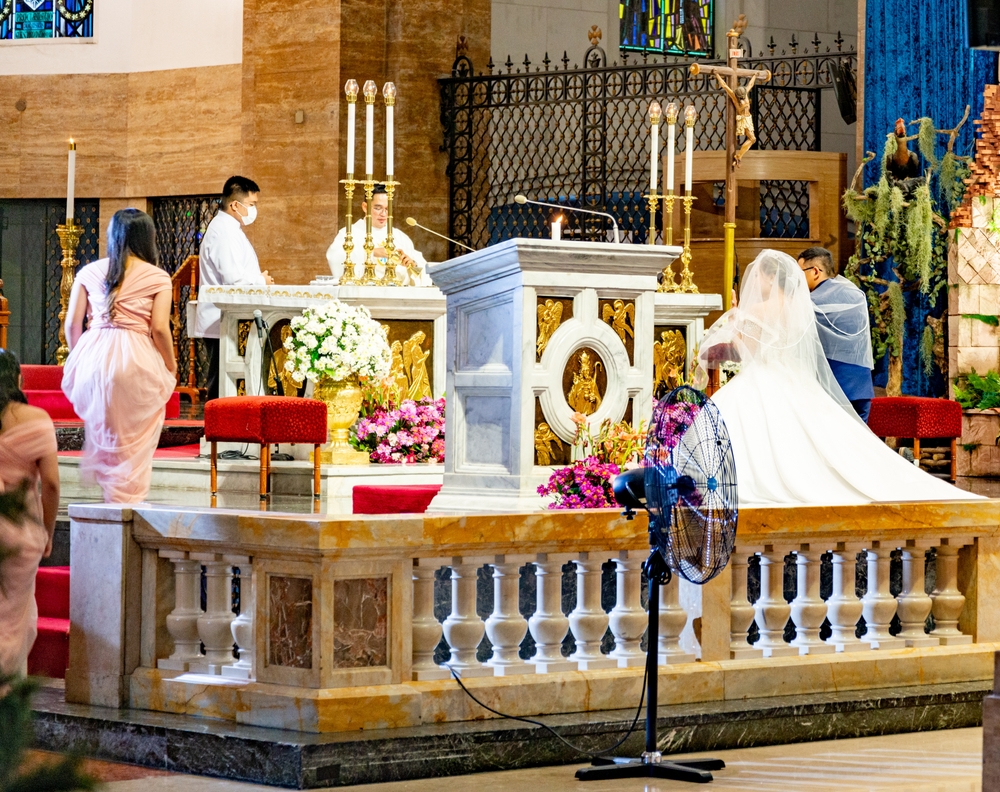Life Stages: Marriage
Marriage Norms
Philippine culture typically views marriage as a divine, sacred, and everlasting union of two individuals. A wedding, or kasalan, is a grand occasion for joy and celebration in every Filipino’s life.
The legal age for marriage in the Philippines is 18 for females and 21 for males. Muslims parents may, however, arrange to have daughters as young as 14 married to older men. Filipinos generally get married before the age of 30, with a median age of 25 for women and 27 for men.
Family hierarchy is very important in arranged marriages in the country. Rural and indigenous families feel obliged to get the older child of the family married before the marriage of his or her younger siblings.
The Ceremony
Most Philippine weddings are conducted according to the Christian tradition (usually Catholic) and are mostly accompanied by a civil ceremony. Soon after the two families reach an agreement, a formal betrothal takes place. Upper- and upper-middle-class families mark betrothals with elaborate parties, while lower-income families observe the custom of a firm handshake and a sip of a homemade wine. While families jointly plan for marriage arrangements, customarily the expense of the wedding ceremony, reception, and feasting are paid by the groom’s side.
A Philippine bride typically dresses up in a white wedding gown (adorned with ribbons and flowers) and veil and is accompanied by bridesmaids. The groom wears a black tuxedo or the traditional Philippine barong tagalog with black pants and is attended by groomsmen. A barong is a thin embroidered formal shirt made from silky ecru fabrics (extracted from pina or pineapple fiber), and it has been the most popular wedding attire for Philippine men for centuries. Some male wedding guests may also come in their best barong.
Catholic weddings in the Philippines are commonly conducted in a church or cathedral. They are legally binding even without a civil ceremony. Usually about 700 people participate in the wedding ceremonies, including immediate family members, relatives, and friends. The highlight is the four sets of male and female sponsors (ninang and ninong) who perform several rituals for the wedding couple during the actual wedding ceremony.
The primary sponsors are godparents, close friends, or favorite uncles and aunts who act as witnesses to the marriage and often provide financial support for the wedding. Secondary sponsors are usually well-respected couples in the community or the wedding party who assist during particular parts of the marriage ceremony. For instance, veil sponsors typically cover or pin the groom’s shoulder with the bride’s white veil, symbolizing that the marriage couple’s clothes are as one.
Cord sponsors tie the couple with the vugal (a decorative ceremonial wedding cord made with silk, flowers, or coins) in a figure-eight shape to signify the infinite spiritual togetherness of the two souls and eternal fidelity. Candle sponsors light two candles to be simultaneously used by the bride and groom to light a single “unity” candle that is believed to invoke Christ’s blessings throughout the couple’s married life and to symbolically represent the uniting of the two families.
The traditional wedding gift from the groom to the bride is the arrhae, or 13 golden wedding coins (typically blessed by the priest) as a symbol of faithfulness, prosperity, and well-being throughout their married life. Philippine jewelry shops usually give the coins away free of cost along with the purchase of the wedding ring. Unlike Western cultures, Philippine couples wear their wedding rings on their right hands.
Marriage celebrations in the Philippines include elaborate feasts, many guests, folk songs, dancing, and a grand reception. Traditionally, a money dance marks the conclusion of the wedding reception in Philippine culture, wherein male guests pay for the privilege of dancing with the new bride by pinning money to her dress. These marriage rituals and customs vary among different Christian denominations and ethnic subcultures.
After the Vows
Filipino couples are responsible for forming a separate household, giving birth to children, raising a family, and carrying forward the family name. Young people have the freedom to choose their life partners and generally have equal legal rights after they are married.
Parents and in-laws in traditional communities are very much involved in their offspring’s marriages. In rural areas, parents typically arrange marriages with the help of elder female relatives and long-term family acquaintances. Cohabitation and common-law marriages are also, on the rise in contemporary Philippines.
Newlyweds in the country still usually live in one of the spouse’s parents’ home and only move to their own separate household after obtaining financial stability. Unmarried younger siblings live in the houses of their married siblings to receive monetary support, to maintain closeness, and sometimes to render help in domestic duties.
Polygamy is neither legally nor culturally accepted in the Philippines, except in some rare cases in the Muslim community. Society condones the practice of men having many mistresses, and cases where men have children outside their marriage certainly exist.
Divorce
Due to the strong influence of Catholicism and Philippine law (which considers divorce illegal), long-lasting marriages are more common than legal separations in the Philippines. Marriages can be dissolved by a judicial decree of separation that specifies child support, the custody of children, and parental authority. Women are usually granted custody of children, especially if the children are very young.
Philippine civil law guarantees women the same legal rights as men in a marriage. Although divorce is not recognized under Philippine law, both men and women can initiate legal separation in the courts through an explicit written or verbal request. In the event of a legal separation, the judge determines child custody by considering the child’s best interests, and women with little or no source of income may obtain monetary support in the form of alimony from their husbands.
Divorces and remarriages may be socially accepted in contemporary Philippine culture, but the Catholic Church still doesn’t approve of remarriage without the annulment of the previous marriage. The church can annul a Catholic marriage on various grounds including adultery, physical violence, physical incapacity, and the pressure to change one's religious or political beliefs.
Copyright © 1993—2025 World Trade Press. All rights reserved.

 Philippines
Philippines 


